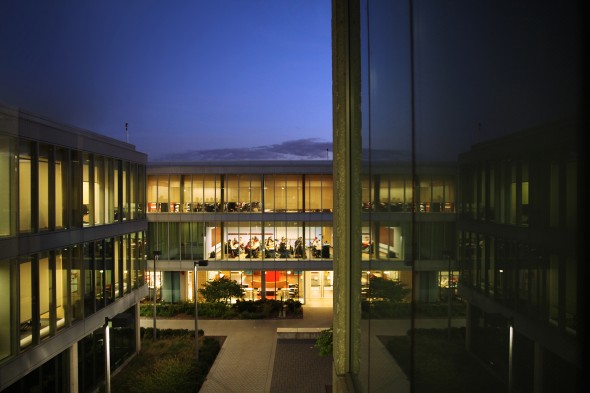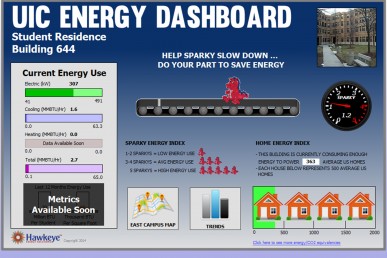Student project measures building energy use in Sparkys

Nine campus buildings have dashboards that show the building’s energy use, measured by UIC mascot Sparky D. Dragon. Project organizers believe showing people real-time energy use makes them more likely to take energy-saving steps.
How much energy are you using on campus? Sparky D. Dragon can show you.
Nine campus buildings are displaying dashboards that show energy use, measured by UIC mascot Sparky D. Dragon. One or two Sparkys means energy consumption is low; five Sparkys shows high energy use in the building.
The dashboards are on display in the student centers, Student Recreation Facility, Science and Engineering Laboratory East, Lincoln Hall and four campus residence halls: James Stukel Towers, Student Residence and Commons South, Student Residence Hall and Polk Street Residence.
Office of Sustainability student interns helped launch the dashboard project this summer.
“If people on campus are able to view the real-time energy usage of different buildings at UIC, they will probably be more likely to make decisions that are sustainable, such as making use of the revolving doors and not holding doors open to keep in heat or cool air inside of buildings,” said Sam Strader, a 2015 graduate in urban and public affairs who interned with the UIC Office of Sustainability this summer.
The dashboards are the most recent campus initiative to get students and employees involved in UIC’s energy conservation efforts, said Cindy Klein-Banai, associate chancellor for sustainability.
“It’s really about behavioral change and how we engage people in how they use energy,” she said.
Over the past four years, UIC has installed smart meters — which show real-time energy consumption and send readings to energy suppliers — on about 30 campus buildings, said Vytenis Milunas, director of project management in Facilities Management.
“If you can’t see where energy is being wasted, you can’t fix it,” he said.
Other recent energy improvement projects include energy-efficient lights in campus buildings, updated air conditioning systems and replacement of leaky underground pipes used to heat and cool campus buildings, Milunas said.
“We are trying to use the same water over and over to heat all of the buildings and the more we get back, the less we have to use new water,” he said. “Plugging the leaks reduces water and energy use.”
These efforts are paying off, Klein-Banai said.
“We are seeing a downward trend in energy consumption and that means that the cumulative efforts of all the projects are having an impact,” she said. “We are definitely going in the right direction but we have a lot of potential opportunities.”
Still, there’s only so much the university can do to reduce its energy consumption, said Robert Roman, director of utilities.
“We are putting in energy-efficient devices but the campus population is growing and habits change and usage goes up,” he said. “We still need to change our culture of energy reduction.”
Students and employees can make small changes to help reduce energy, Klein-Banai said, such as turning off lights and unplugging electronics.
“We think conservation behaviors will transfer both ways, from UIC to home,” she said.
Sustainability is a top priority in campus construction and renovation projects, Roman said. “It’s very important to the senior leadership of this university that we consider any and all ways in which we can be more conservative in our energy consumption,” he said.
Strader said he hopes the campus efforts help students consider sustainability in their choices. “I hope more people think about their energy usage and thus their carbon footprint not only at UIC but in the rest of the areas of their life,” he said.

